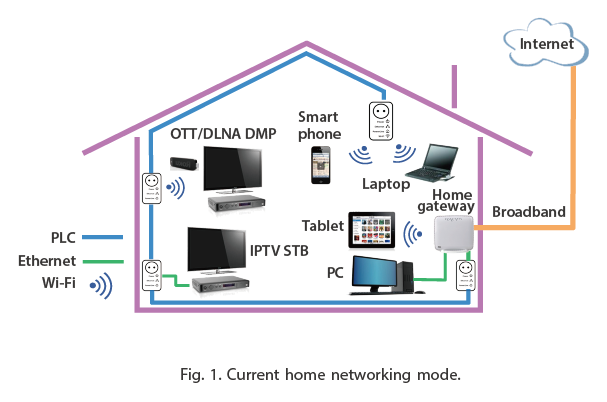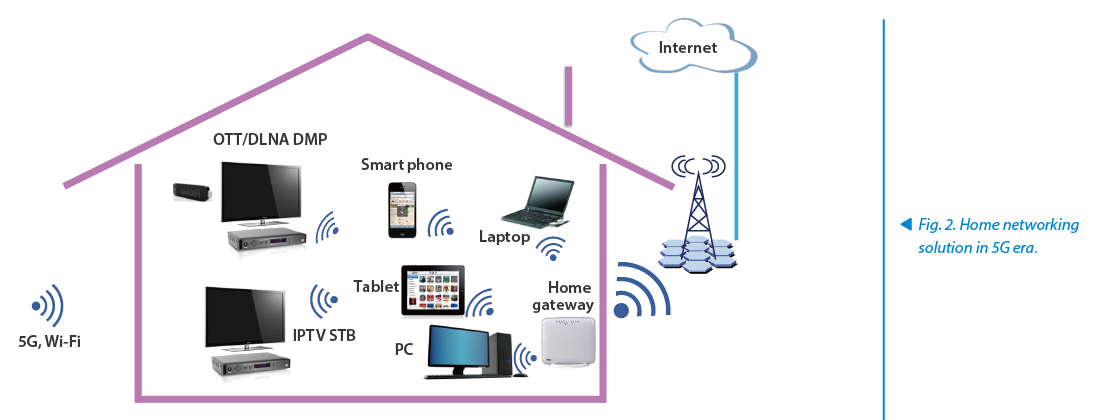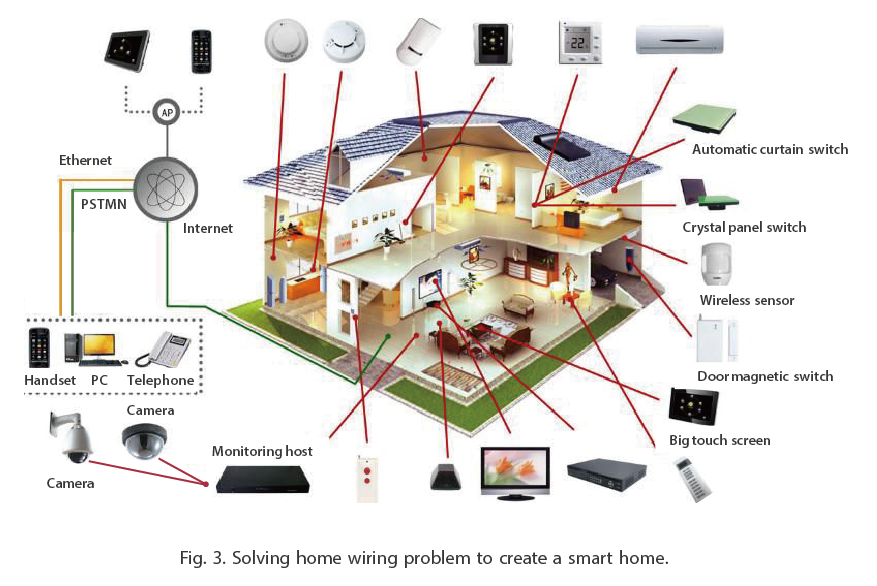Key Technologies for STBs in 5G Era
Much different from previous generations of wireless standards where applications were driven by technologies, 5G technology has been driven by specific uses and applications. 5G will come with many improvements to meet multiple scenarios, such as continuous wide-area coverage, high capacity hotspots, and low-power massive-connections. Video, an indispensable service to users, will also embrace new opportunities with the arrival of 5G.
As a multimedia terminal device, the set-top box (STB) will undergo a revolutionary transformation along with the new developments in video.
Access Mode
5G with the high bandwidth feature will transform the access mode. Different types of users are supported over the same physical 5G network, which logically includes fixed network users. In 5G, fixed and mobile networks will interwork and collaborate for full-service and integrated-service operation.
Current Home Networking Mode

Home Networking Mode in 5G Era

— Integrating WLAN management and 5G NE for management
— Higher mobility guaranteed by a 5G cellular network
— Seamless service integration; real-time switch between licensed spectrum (5G) and unlicensed spectrum (WiFi); flexible deployments
Smart Home with IoT
5G can effectively solve network deployment and device access problems to realize the IoT potential. More and more smart home devices will deployed around the home (Fig. 3). For example, the home monitoring device integrated with the home base station function supports wireless upload and makes device placement and management more convenient. Personal devices, like mobile phone, allow users to view and control smart home devices more conveniently. 5G could promote a boom in smart home, and a uniform network architecture allows better management of smart home devices.

With rapid development of ultra HD video, video has entered the 4K era. Here is a brief exploration of how it will evolve in the future.
From 4K to 8K
Japan will broadcast the Tokyo Olympics in 8K in 2020. In September 2018, China Unicom announced its 5G+8K live broadcast solution, which is going to be used in the Beijing 2022 Winter Olympics. Demands for service will bring higher resolution videos. 8K encoding and related transmission standards have gradually matured, and it is expected that 8K video will come into market in next 2-3 years. Video is entering the era of 8K along with the arrival of 5G.
From Single-Screen to Multi-Screen
TV dominates the traditional multimedia landscape. Mobile devices like smartphone allow users to display contents from their phone on a bigger TV screen. With developments in video technology, network access capacity and processing capacity of terminal devices, new multi-screen services have emerged, such as PIP, multi-screen viewing (four concurrent streams), and nine-screen program guide.
From 2D to 3D
Traditional videos come in two dimensions. However, with the development of VR technology, 3D video services are growing, especially 360-degree omnidirectional video and 120-degree wide angle 3D video. Developments in interactive operations have further transformed the user experience.
From One-Way to Interaction
Traditional video service is one-way broadcasting (for example DVB). Interactivity emerged in the era of IPTV/OTT but it is only limited to program selection. In the future, the multi-screen mode and integration of VR services, when coupled with the high bandwidth of 5G, will enable Director Mode, which allows users to dynamically select video shooting angle, and God Mode which allows users to watch videos shot from different angles of view simultaneously. Such kinds of services will be given full play in live streaming events such as electronic sports, concerts and ball games.
From Non-Intelligent to Intelligent
AI technology has improved greatly in recent years and is increasingly being incorporated into the video industry. Terminal devices integrated with far-field vice recognition have the ability to “listen” and, when connected with the background AI system, also have the ability to “think” and “speak”. Terminal devices, which used to be operated by a remote control, now have the ability to communicate with users. With the development of AI technology, multimedia devices will make good companions for children and elderly people at home.
Video and Audio Technology
The move to 5G will transform access technologies and services. Since the demand for 5G technology has been driven by new services, video and audio technologies will also have revolutionary changes.
Encoding/Decoding Technology
Currently, H.265/HEVC is the mainstream codec for 4K video, which contributes greatly to 4K service development. However, HEVC licensing is complex and uncertain. There are now three patent pools, one of which has not published their license, and a significant number of patent holders that have not published their licenses. It is believed there is going to be a huge cost for the whole industry chain.
To avoid above-mentioned risks, several organizations have proposed alternative solutions.
— AVS: AVS is created in China. AVS2.0 is the latest codec standard for 4K video. Tests have shown that AVS2.0 has advantages over H.265/HEVC in terms of encoding rate and efficiency. Many Chinese and overseas operators have included support for AVS2.0 in their bid specifications.
— AV1: The Alliance for Open Media (AOMedia) is backed by leading members like Google. It released the AV1 royalty-free video format in March 2018. The technical disadvantage of AV1 is its optimization algorithm. As a result of avoiding patent issues, AV1 encoding is very slow when compared with H.265/HEVC.
— XVC: The Swedish company Divideon has developed XVC codec based on MPEG/VCEG technology. The codec is available under a single license approach. The latest version of XVC (2.0) was released in July 2018. XVC is said to outperform HEVC by around 20% and AV1 by around 10%. It still takes a long time for this codec to gain industry-wide recognition.
— VVC: The Joint Video Experts Team (JVET) commenced work on a new coding standard known as Versatile Video Coding (VVC) in 2018. It faces great difficulties to compete with other video coding standards developed earlier.
While the 4K video codec battle is in full swing, work on new specifications concerning 8K and full-view video is underway. MPEG's FVC/H.266 is expected to be ready in several years. The AVS 3.0 standard for 8K is being formulated with the first edition to be released in 2019.
Other Technologies
— HDR: HDR is one of the most important aspects of ultra HD video, providing greater brightness levels in low-light scenes. HDR10, HLG and Dolby Vision are three major HDR standards and each has its own supporters. These standards will coexist for a long time and terminal devices have to support all of them.
— WCG: The BT.2020 standard for Wide Color Gamut (WCG) has defined the color space for ultra HD TVs. 10-bit color depth is designated for 4K and 12-bit for 8K.
— New-generation video and audio transmission technologies: New technologies and services in 5G era put higher requirements on traditional transmission technologies. MPEG's Common Media Application Format (CMAF) aims at unifying two leading streaming protocols (HLS and MPEG-DASH) and adding support for new services like VR. In the future, transmission technologies such as QUIC and HTTP/2 will be introduced to further reduce the latency.
Summary
5G will have a drastic impact on the fast-growing multimedia video industry. ZTE will keep a close eye on the latest technology trends, specifications and services, explore new market opportunities, and help operators create more value in the new era.
[Keywords] STB, 5G era, Access mode, home networking mode, smart home, single-screen, multi-screen, 5G+8k live broadcast